Global Assessment of Groundwater Stress Vis-à-Vis Sustainability of Irrigated Food Production
Abstract
:1. Introduction
2. Materials and Methods
2.1. Computation of Groundwater Stress
- NRGA = Non-renewable groundwater abstraction for irrigation (mm year−1)
- IWWgw = Irrigation water withdrawal from groundwater (mm year−1)
- IWR = Irrigation water requirement met from groundwater (mm year−1)
- R = Groundwater recharge (mm year−1)
- EBFR = Environmental baseflow requirement (mm year−1)
- SR = Groundwater Stress index (-)
- H = Country-level irrigation efficiency (-)
2.2. Estimation of Groundwater Availability for Irrigation
2.3. Estimation of Water Use
2.4. Unsustainable Food Production from Groundwater
- Ygw = Total food production from groundwater irrigated area (tonnes)
- Ytot = Average yield from irrigated area (t ha−1)
- AIgw = Total groundwater irrigated area (ha)
- Ypgw = Yield from groundwater withdrawn (t ML−1)
- Ypnrgb = Yield from non-renewable groundwater abstraction (t ML−1)
- IWWgw = Groundwater withdrawn for irrigation (ML)
- η = Current irrigation efficiency
- ηnew = Efficiency in different scenarios
2.5. Data Sources
3. Results
3.1. Non-Renewable Groundwater Abstraction and Stress Index
3.2. Unsustainable Food Production from Groundwater
3.3. Groundwater Stress Reduction Scenarios
4. Discussion
5. Conclusions
Author Contributions
Funding
Data Availability Statement
Acknowledgments
Conflicts of Interest
References
- Bin Abdullah, K. Use of Water and Land for Food Security and Environmental Sustainability. Irrig. Drain. 2006, 55, 219–222. [Google Scholar] [CrossRef]
- Wada, Y.; van Beek, L.P.H.; Bierkens, M.F.P. Nonsustainable Groundwater Sustaining Irrigation: A Global Assessment. Water Resour. Res. 2012, 48. [Google Scholar] [CrossRef]
- Khan, S.; Tariq, R.; Yuanlai, C.; Blackwell, J. Can Irrigation Be Sustainable? Agric. Water Manag. 2006, 80, 87–99. [Google Scholar] [CrossRef]
- Tracy, J.; Johnson, J.; Konikow, L.F.; Miller, G.; Porter, D.; Sheng, Z.; Sibray, S. Aquifer Depletion and Potential Impacts on Long-Term Irrigated Agricultural Productivity; Council for Agricultural Science and Technology: Ames, IA, USA, 2019. [Google Scholar]
- de Graaf, I.E.; Gleeson, T.; Sutanudjaja, E.H.; Bierkens, M.F. Environmental Flow Limits to Global Groundwater Pumping. Nature 2019, 574, 90–94. [Google Scholar] [CrossRef]
- National Ground Water Association. Facts about Global Groundwater Usage. 2016. Available online: https://www.ngwa.org/Fundamentals/Documents/globalgroundwater-use-fact-sheet.pdf (accessed on 8 June 2017).
- Krishan, G.; Bisht, M.; Ghosh, N.C.; Prasad, G. Groundwater Salinity in Northwestern Region of India: A Critical Appraisal. In Environmental Processes and Management; Springer: Cham, Switzerland, 2020; pp. 361–380. [Google Scholar]
- Gleeson, T.; Richter, B. How Much Groundwater Can We Pump and Protect Environmental Flows through Time? Presumptive Standards for Conjunctive Management of Aquifers and Rivers. River Res. Appl. 2018, 34, 83–92. [Google Scholar] [CrossRef]
- van Dijk, M.; Morley, T.; Rau, M.L.; Saghai, Y. A Meta-Analysis of Projected Global Food Demand and Population at Risk of Hunger for the Period 2010–2050. Nat. Food 2021, 2, 494–501. [Google Scholar] [CrossRef]
- Dragoni, W.; Sukhija, B.S. Climate Change and Groundwater: A Short Review. SP 2008, 288, 1–12. [Google Scholar] [CrossRef]
- Green, T.R.; Taniguchi, M.; Kooi, H.; Gurdak, J.J.; Allen, D.M.; Hiscock, K.M.; Treidel, H.; Aureli, A. Beneath the Surface of Global Change: Impacts of Climate Change on Groundwater. J. Hydrol. 2011, 405, 532–560. [Google Scholar] [CrossRef] [Green Version]
- Taylor, R.G.; Scanlon, B.; Döll, P.; Rodell, M.; Van Beek, R.; Wada, Y.; Longuevergne, L.; Leblanc, M.; Famiglietti, J.S.; Edmunds, M. Ground Water and Climate Change. Nat. Clim. Chang. 2013, 3, 322–329. [Google Scholar] [CrossRef] [Green Version]
- Jasechko, S.; Perrone, D. Global Groundwater Wells at Risk of Running Dry. Science 2021, 372, 418–421. [Google Scholar] [CrossRef]
- Dalin, C.; Taniguchi, M.; Green, T.R. Unsustainable Groundwater Use for Global Food Production and Related International Trade. Glob. Sustain. 2019, 2, e12. [Google Scholar] [CrossRef] [Green Version]
- Llamas, M.R.; Martínez-Santos, P. Intensive Groundwater Use: Silent Revolution and Potential Source of Social Conflicts. J. Water Resour. Plann. Manag. 2005, 131, 337–341. [Google Scholar] [CrossRef]
- Shah, T. Climate Change and Groundwater: India’s Opportunities for Mitigation and Adaptation. Environ. Res. Lett. 2009, 4, 035005. [Google Scholar] [CrossRef]
- Shah, T.; Singh, O.P.; Mukherji, A. Groundwater Irrigation and South Asian Agriculture: Empirical Analyses from a Large-Scale Survey of India, Pakistan, Nepal Terai and Bangladesh. In Proceedings of the IWMI-Tata Annual Partners’ Meeting, Anand, India, 17–19 February 2004; pp. 17–19. [Google Scholar]
- de Graaf, I.E.M.; van Beek, R.L.P.H.; Gleeson, T.; Moosdorf, N.; Schmitz, O.; Sutanudjaja, E.H.; Bierkens, M.F.P. A Global-Scale Two-Layer Transient Groundwater Model: Development and Application to Groundwater Depletion. Adv. Water Resour. 2017, 102, 53–67. [Google Scholar] [CrossRef]
- Gleeson, T.; Wada, Y. Assessing Regional Groundwater Stress for Nations Using Multiple Data Sources with the Groundwater Footprint. Environ. Res. Lett. 2013, 8, 044010. [Google Scholar] [CrossRef]
- Herbert, C.; Döll, P. Global Assessment of Current and Future Groundwater Stress With a Focus on Transboundary Aquifers. Water Resour. Res. 2019, 55, 4760–4784. [Google Scholar] [CrossRef]
- Gleeson, T.; Wada, Y.; Bierkens, M.F.P.; van Beek, L.P.H. Water Balance of Global Aquifers Revealed by Groundwater Footprint. Nature 2012, 488, 197–200. [Google Scholar] [CrossRef]
- Famiglietti, J.S.; Lo, M.; Ho, S.L.; Bethune, J.; Anderson, K.J.; Syed, T.H.; Swenson, S.C.; de Linage, C.R.; Rodell, M. Satellites Measure Recent Rates of Groundwater Depletion in California’s Central Valley. Geophys. Res. Lett. 2011, 38. [Google Scholar] [CrossRef] [Green Version]
- Feng, W.; Zhong, M.; Lemoine, J.-M.; Biancale, R.; Hsu, H.-T.; Xia, J. Evaluation of Groundwater Depletion in North China Using the Gravity Recovery and Climate Experiment (GRACE) Data and Ground-Based Measurements. Water Resour. Res. 2013, 49, 2110–2118. [Google Scholar] [CrossRef]
- Joodaki, G.; Wahr, J.; Swenson, S. Estimating the Human Contribution to Groundwater Depletion in the Middle East, from GRACE Data, Land Surface Models, and Well Observations. Water Resour. Res. 2014, 50, 2679–2692. [Google Scholar] [CrossRef]
- Rodell, M.; Velicogna, I.; Famiglietti, J.S. Satellite-Based Estimates of Groundwater Depletion in India. Nature 2009, 460, 999–1002. [Google Scholar] [CrossRef] [Green Version]
- Wada, Y.; van Beek, L.P.H.; van Kempen, C.M.; Reckman, J.W.T.M.; Vasak, S.; Bierkens, M.F.P. Global Depletion of Groundwater Resources. Geophys. Res. Lett. 2010, 37. [Google Scholar] [CrossRef] [Green Version]
- Tuninetti, M.; Tamea, S.; Dalin, C. Water Debt Indicator Reveals Where Agricultural Water Use Exceeds Sustainable Levels. Water Resour. Res. 2019, 55, 2464–2477. [Google Scholar] [CrossRef] [Green Version]
- Jägermeyr, J.; Pastor, A.; Biemans, H.; Gerten, D. Reconciling Irrigated Food Production with Environmental Flows for Sustainable Development Goals Implementation. Nat. Commun. 2017, 8, 15900. [Google Scholar] [CrossRef] [Green Version]
- Pastor, A.V.; Ludwig, F.; Biemans, H.; Hoff, H.; Kabat, P. Accounting for Environmental Flow Requirements in Global Water Assessments. Hydrol. Earth Syst. Sci. 2014, 18, 5041–5059. [Google Scholar] [CrossRef] [Green Version]
- Dalin, C.; Wada, Y.; Kastner, T.; Puma, M.J. Groundwater Depletion Embedded in International Food Trade. Nature 2017, 543, 700–704. [Google Scholar] [CrossRef] [Green Version]
- Raskin, P.; Gleick, P.; Kirshen, P.; Pontius, G.; Strzepek, K. Water Futures: Assessment of Long-Range Patterns and Problems. Comprehensive Assessment of the Freshwater Resources of the World; SEI: Stockholm, Sweden, 1997. [Google Scholar]
- Smakhtin, V.; Revenga, C.; Döll, P. A Pilot Global Assessment of Environmental Water Requirements and Scarcity. Water Int. 2004, 29, 307–317. [Google Scholar] [CrossRef]
- Mohan, C.; Western, A.W.; Wei, Y.; Saft, M. Predicting Groundwater Recharge for Varying Land Cover and Climate Conditions–a Global Meta-Study. Hydrol. Earth Syst. Sci. 2018, 22, 2689–2703. [Google Scholar] [CrossRef] [Green Version]
- Hoogeveen, J.; Faurès, J.-M.; Peiser, L.; Burke, J.; van de Giesen, N. GlobWat—A global water balance model to assess water use in irrigated agriculture. Hydrol. Earth Syst. Sci. 2015, 19, 3829–3844. [Google Scholar] [CrossRef] [Green Version]
- FAO. State of the World’s Land and Water Resources for Food and Agriculture (SOLAW); Food and Agriculture Organization of the United Nations: Rome, Italy; Earthscan: London, UK, 2011. [Google Scholar]
- FAOSTAT. Crop Production Statistics; Food and Agriculture Organization of the United Nations (FAO): Rome, Italy, 2016. [Google Scholar]
- Siebert, S.; Henrich, V.; Frenken, K.; Burke, J. Update of the Digital Global Map of Irrigation Areas to Version 5; FAO: Rome, Italy, 2013. [Google Scholar]
- FAO. AQUASTAT Main Database; Food and Agriculture Organization of the United Nations: Rome, Italy, 2016. [Google Scholar]
- Beck, H.E.; de Roo, A.; van Dijk, A.I.J.M. Global Maps of Streamflow Characteristics Based on Observations from Several Thousand Catchments. J. Hydrometeorol. 2015, 16, 1478–1501. [Google Scholar] [CrossRef] [Green Version]
- Beck, H.E.; van Dijk, A.I.J.M.; Miralles, D.G.; de Jeu, R.A.M.; (Sampurno) Bruijnzeel, L.A.; McVicar, T.R.; Schellekens, J. Global Patterns in Base Flow Index and Recession Based on Streamflow Observations from 3394 Catchments. Water Resour. Res. 2013, 49, 7843–7863. [Google Scholar] [CrossRef] [Green Version]
- Sood, A.; Smakhtin, V.; Eriyagama, N.; Villholth, K.G.; Liyanage, N.; Wada, Y.; Ebrahim, G.; Dickens, C. Global Environmental Flow Information for the Sustainable Development Goals; International Water Management Institute (IWMI): Colombo, Sri Lanka, 2017; Volume 168, ISBN 92-9090-847-5. [Google Scholar]
- Famiglietti, J.S. The Global Groundwater Crisis. Nat. Clim. Chang. 2014, 4, 945–948. [Google Scholar] [CrossRef] [Green Version]
- Verma, S.; Tsephal, S.; Jose, T. Pepsee Systems: Grassroots Innovation under Groundwater Stress. Water Policy 2004, 6, 303–318. [Google Scholar] [CrossRef]
- Richey, A.S.; Thomas, B.F.; Lo, M.-H.; Reager, J.T.; Famiglietti, J.S.; Voss, K.; Swenson, S.; Rodell, M. Quantifying Renewable Groundwater Stress with GRACE. Water Resour. Res. 2015, 51, 5217–5238. [Google Scholar] [CrossRef]
- Blanco-Gutiérrez, I.; Varela-Ortega, C.; Purkey, D.R. Integrated Assessment of Policy Interventions for Promoting Sustainable Irrigation in Semi-Arid Environments: A Hydro-Economic Modeling Approach. J. Environ. Manag. 2013, 128, 144–160. [Google Scholar] [CrossRef] [Green Version]
- UN. World Population Prospects 2022: Summary of Results; UN: New York, NY, USA, 2022; 52p. [Google Scholar]
- Perrone, D.; Jasechko, S. Dry Groundwater Wells in the Western United States. Environ. Res. Lett. 2017, 12, 104002. [Google Scholar] [CrossRef]
- Blakeslee, D.; Fishman, R.; Srinivasan, V. Way down in the Hole: Adaptation to Long-Term Water Loss in Rural India. Am. Econ. Rev. 2020, 110, 200–224. [Google Scholar] [CrossRef] [Green Version]
- Wang, D.; Gao, G.; Li, R.; Toktarbek, S.; Jiakula, N.; Feng, Y. Limiting Factors and Environmental Adaptability for Staple Crops in Kazakhstan. Sustainability 2022, 14, 9980. [Google Scholar] [CrossRef]
- Dubois, O. The State of the World’s Land and Water Resources for Food and Agriculture: Managing Systems at Risk. In The State of the World’s Land and Water Resources for Food and Agriculture: Managing Systems at Risk; FAO: Rome, Italy, 2011. [Google Scholar]
- Mohan, C.; Gleeson, T.; Forstner, T.; Famiglietti, J.S.; de Graaf, I.E. Quantifying Groundwater’s Contribution to Regional Environmental Flows in Diverse Hydrologic Landscapes. ESS Open Arch. 2022. [Google Scholar] [CrossRef]
- Bennion, H.; Battarbee, R. The European Union Water Framework Directive: Opportunities for Palaeolimnology. J. Paleolimnol. 2007, 38, 285–295. [Google Scholar] [CrossRef]
- Slamini, M.; Sbaa, M.; Arabi, M.; Darmous, A. Review on Partial Root-Zone Drying Irrigation: Impact on Crop Yield, Soil and Water Pollution. Agric. Water Manag. 2022, 271, 107807. [Google Scholar] [CrossRef]
- Ayars, J.E.; Hoffman, G.J.; Corwin, D.L. Leaching and Root Zone Salinity Control. Agric. Salin. Assess. Manag. 2012, 12, 371–403. [Google Scholar]
- Pérez-Blanco, C.D.; Hrast-Essenfelder, A.; Perry, C. Irrigation Technology and Water Conservation: A Review of the Theory and Evidence. Rev. Environ. Econ. Policy 2020, 14, 45–66. [Google Scholar] [CrossRef]
- Perry, C. Efficient Irrigation; Inefficient Communication; Flawed Recommendations. Irrig. Drain. 2007, 56, 367–378. [Google Scholar] [CrossRef]
- Ilyas, A.; Manzoor, T.; Muhammad, A. A Dynamic Socio-Hydrological Model of the Irrigation Efficiency Paradox. Water Resour. Res. 2021, 57, e2021WR029783. [Google Scholar] [CrossRef]
- Howell, T.A. Enhancing Water Use Efficiency in Irrigated Agriculture. Agron. J. 2001, 93, 281–289. [Google Scholar] [CrossRef] [Green Version]
- Elliott, J.; Deryng, D.; Müller, C.; Frieler, K.; Konzmann, M.; Gerten, D.; Glotter, M.; Flörke, M.; Wada, Y.; Best, N.; et al. Constraints and Potentials of Future Irrigation Water Availability on Agricultural Production under Climate Change. Proc. Natl. Acad. Sci. USA 2014, 111, 3239–3244. [Google Scholar] [CrossRef] [Green Version]
- Levidow, L.; Zaccaria, D.; Maia, R.; Vivas, E.; Todorovic, M.; Scardigno, A. Improving Water-Efficient Irrigation: Prospects and Difficulties of Innovative Practices. Agric. Water Manag. 2014, 146, 84–94. [Google Scholar] [CrossRef]
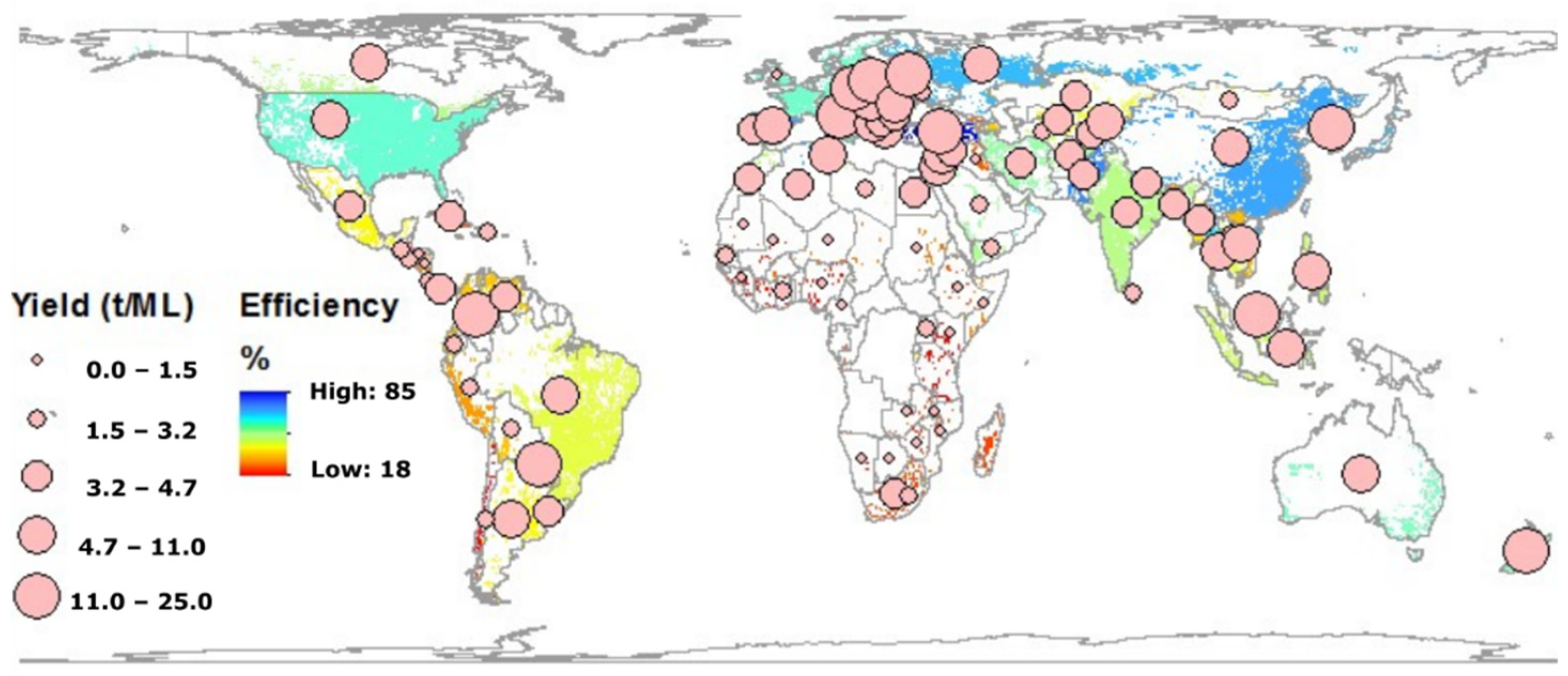

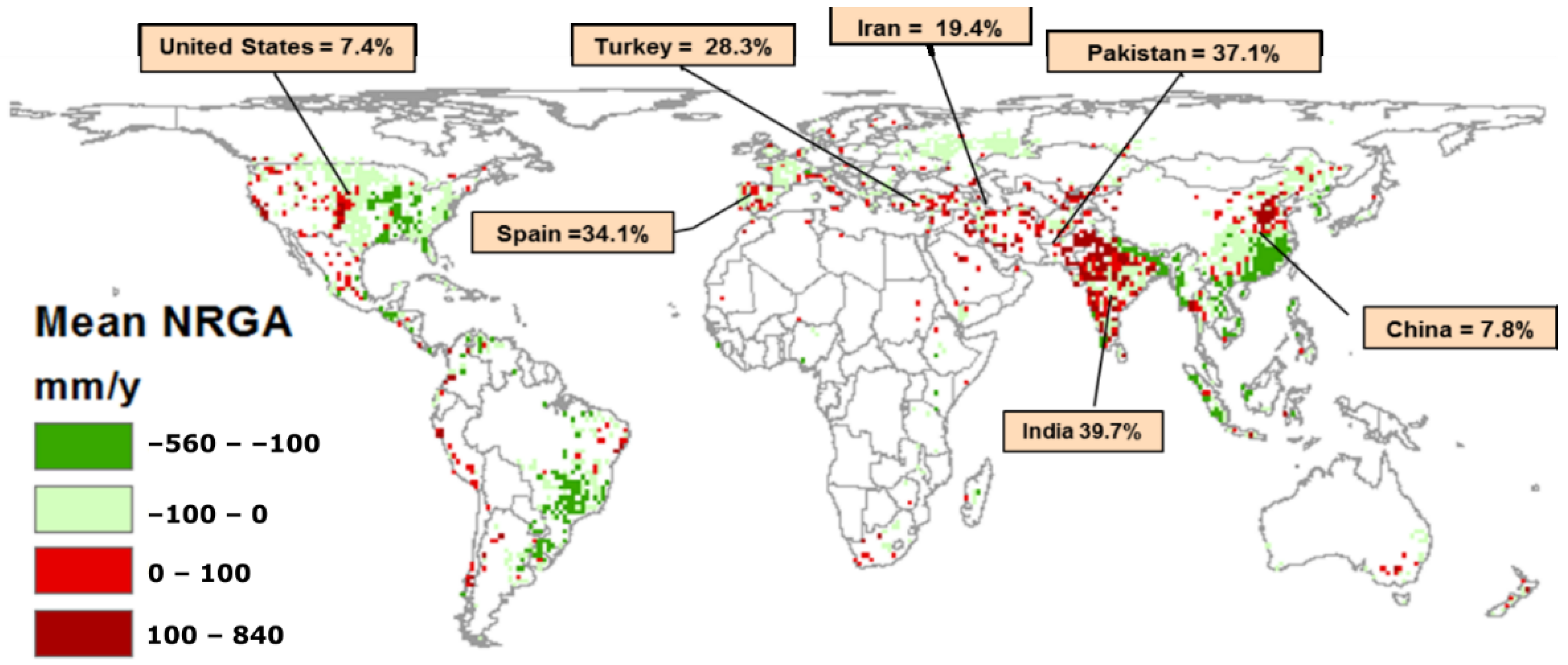
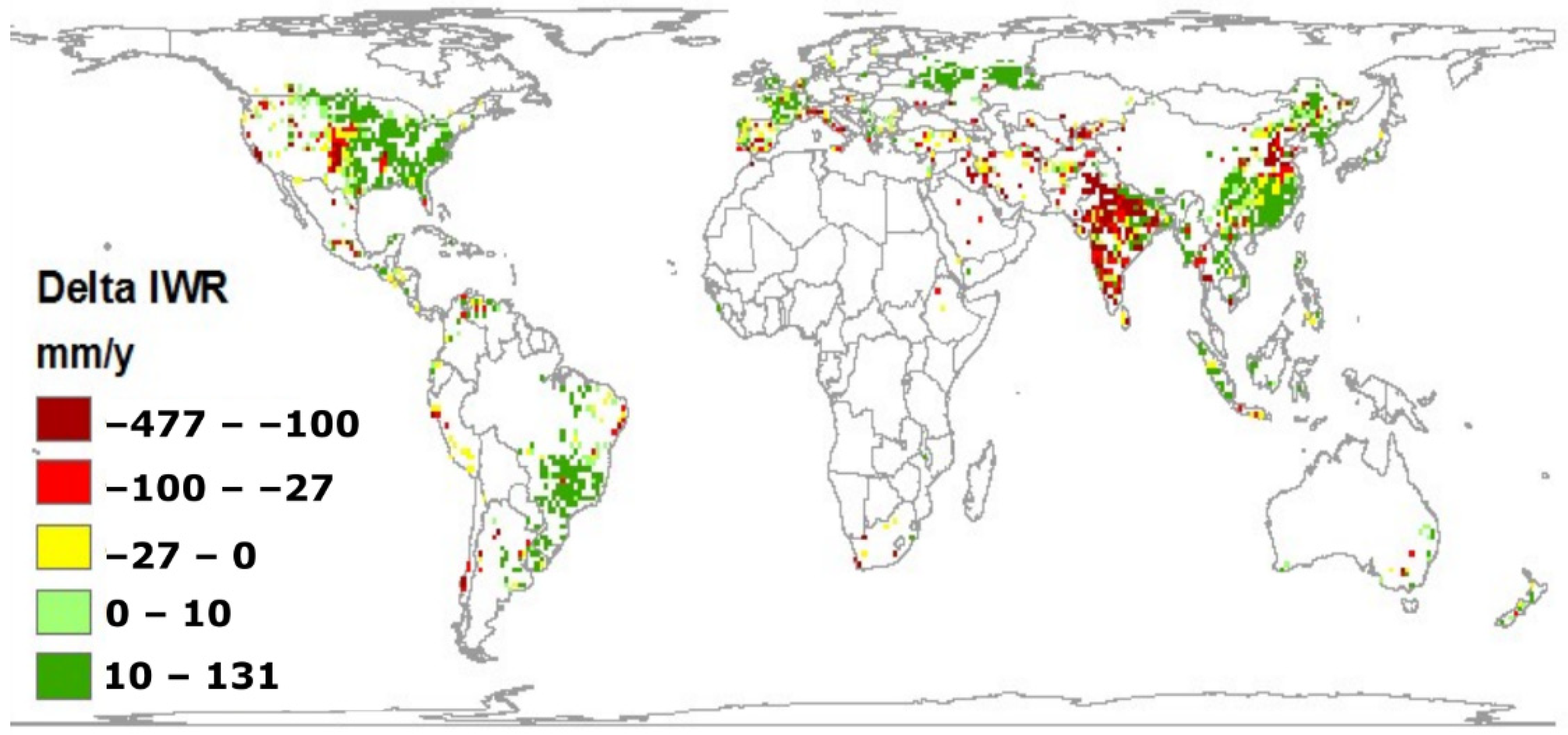
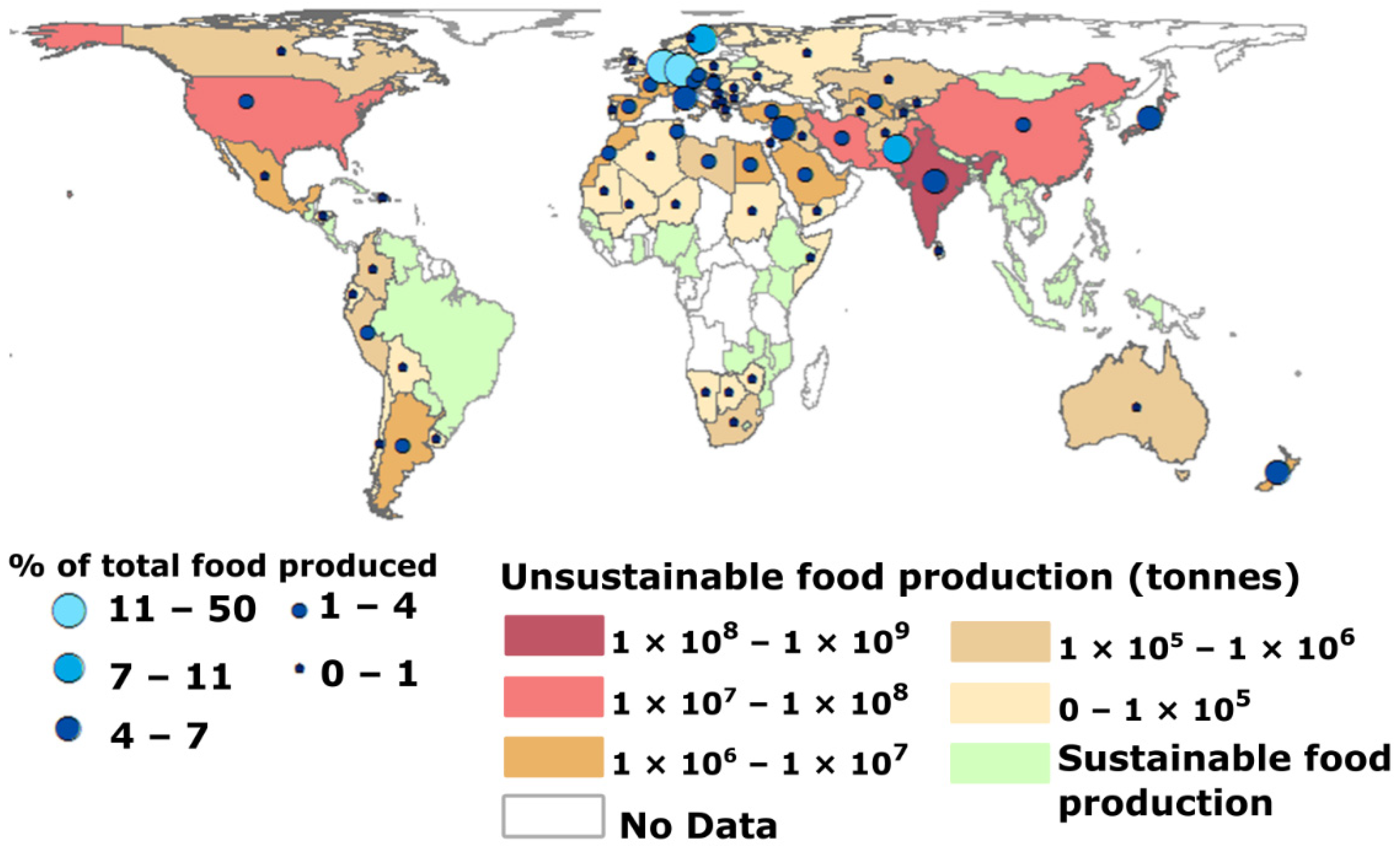

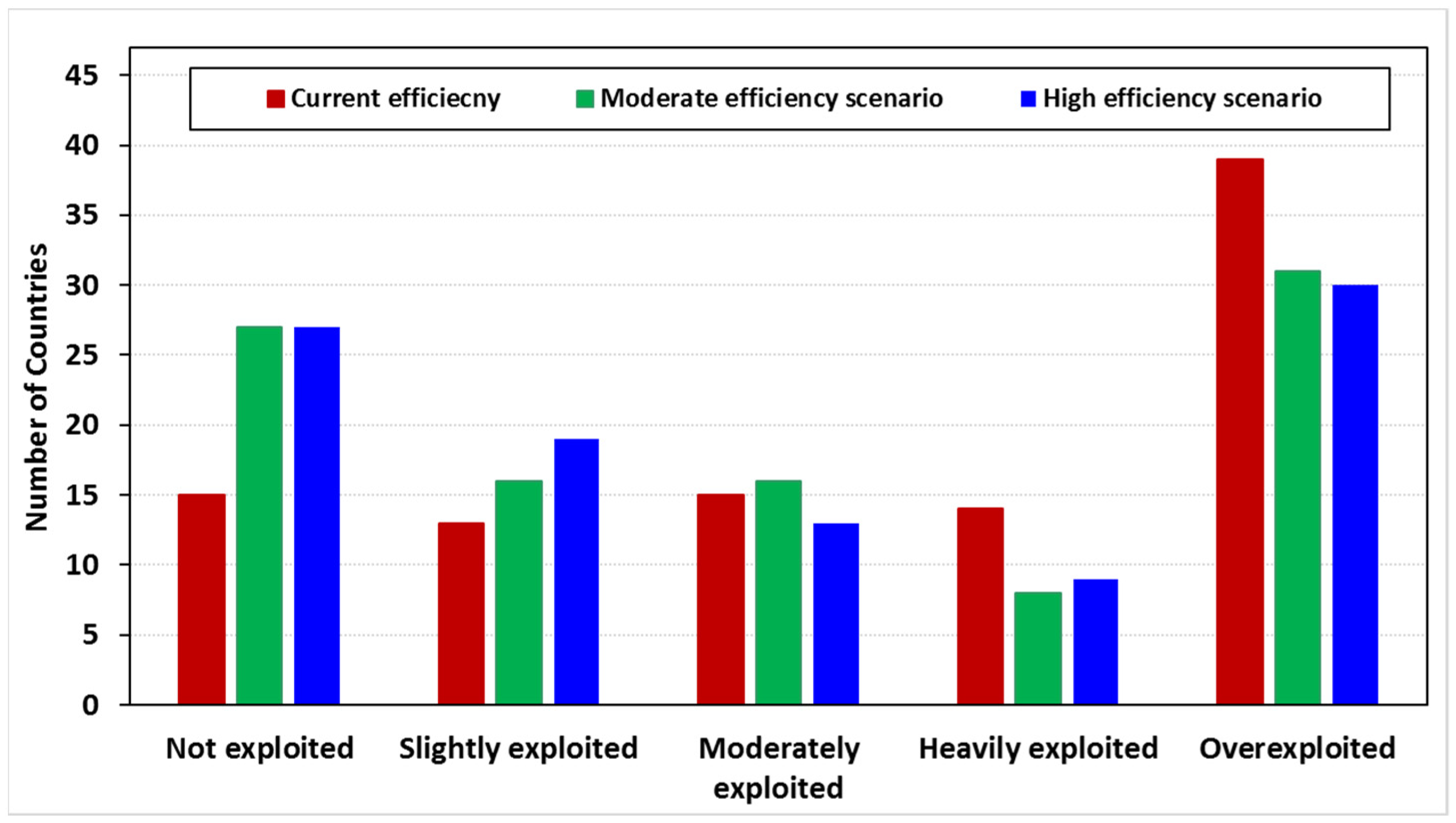
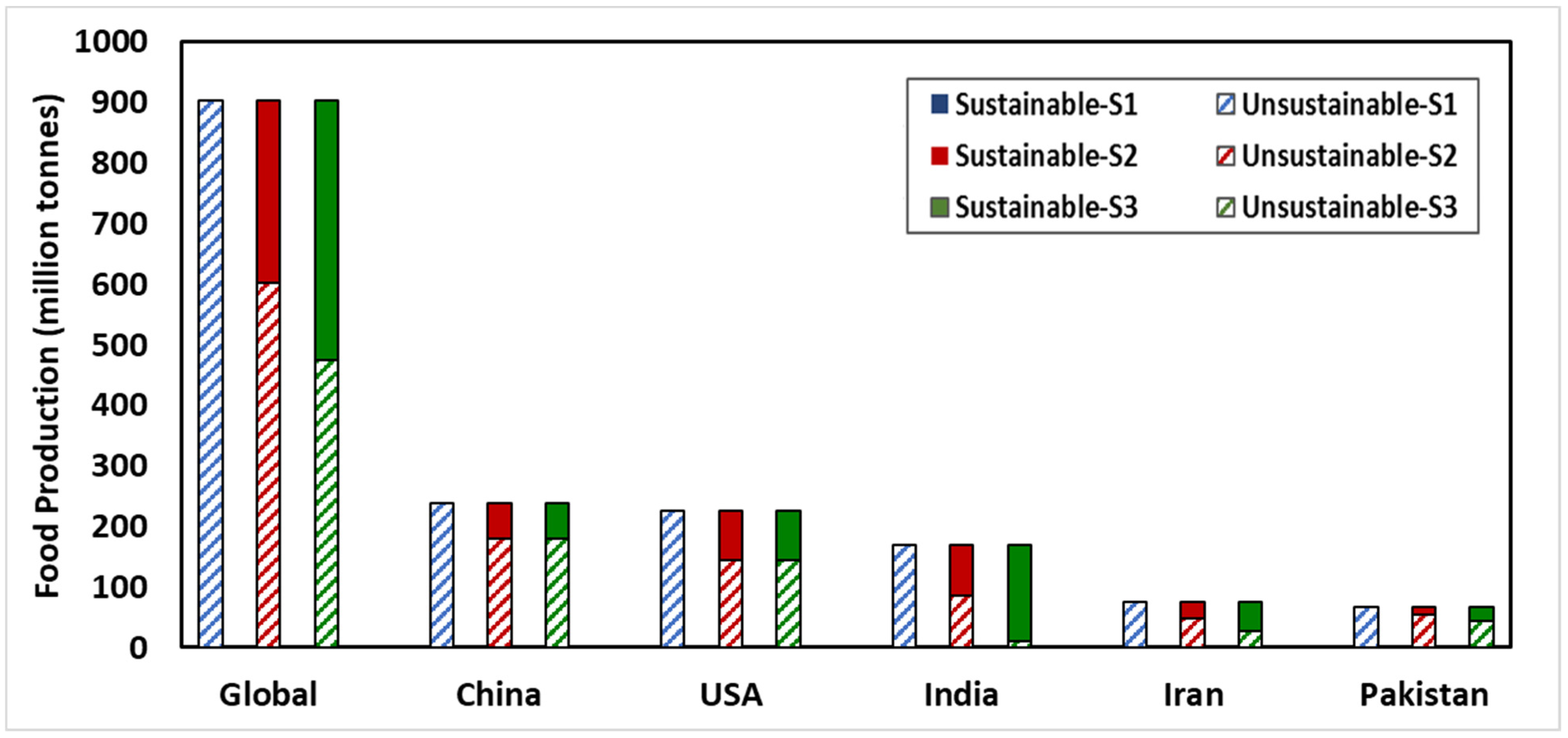
| SR Range | Groundwater Stress Level |
|---|---|
| Not exploited |
| Slightly exploited |
| Moderately exploited |
| Heavily exploited |
| Overexploited |
| Scenario Name | Description |
|---|---|
| S1 | Base Case Scenario: SR ≤ 0.6 |
| S2 | High Efficiency Scenario: Irrigation efficiency = 90% |
| S2a | Moderate Efficiency Scenario: Irrigation efficiency = 75% of the difference between current and maximum efficiency (90%) |
| S3 | High Efficiency and Yield Scenario: Irrigation efficiency = 90%; Irrigation productivity ≥ 8 t/ML |
| Country | NRGA (km3 year−1) Model Used: PCRGlobWB [2] | GWD 1 in Food Production (km3 year−1) Model Used: PCRGlobWB [30] | GWD 1 (km3 year−1) Model Used: WaterGAP2.2a [19] | GWD 1 (km3 year−1) Model Used: WaterGAP 2.2b [19] | NRGA Due to Food Production (km3 year−1) This Study Models Used:– Globwat + Empirical Recharge Model |
|---|---|---|---|---|---|
| India | 68.0 | 73.5 | 61.0 | 40.0 2 | 63.3 |
| Pakistan | 35.0 | 27.5 | - | - | 22.3 |
| China | 20.0 | 24.0 | 37.0 | 21.0 3 | 26.9 |
| United States | 30.0 | 16.2 | 33.4 | 44.3 | 34.7 |
| Iran | 20.0 | 33.3 | - | - | 28.2 |
| Saudi Arabia | 10.0 | 12.5 | - | - | 1.5 |
| Mexico | 11.0 | 11.1 | - | - | 11.2 |
| Turkey | - | 2.0 | - | - | 2.7 |
| Global | 241.4 | - | - | 207.2 |
Publisher’s Note: MDPI stays neutral with regard to jurisdictional claims in published maps and institutional affiliations. |
© 2022 by the authors. Licensee MDPI, Basel, Switzerland. This article is an open access article distributed under the terms and conditions of the Creative Commons Attribution (CC BY) license (https://creativecommons.org/licenses/by/4.0/).
Share and Cite
Mohan, C.; Western, A.W.; Jha, M.K.; Wei, Y. Global Assessment of Groundwater Stress Vis-à-Vis Sustainability of Irrigated Food Production. Sustainability 2022, 14, 16896. https://doi.org/10.3390/su142416896
Mohan C, Western AW, Jha MK, Wei Y. Global Assessment of Groundwater Stress Vis-à-Vis Sustainability of Irrigated Food Production. Sustainability. 2022; 14(24):16896. https://doi.org/10.3390/su142416896
Chicago/Turabian StyleMohan, Chinchu, Andrew W. Western, Madan Kumar Jha, and Yongping Wei. 2022. "Global Assessment of Groundwater Stress Vis-à-Vis Sustainability of Irrigated Food Production" Sustainability 14, no. 24: 16896. https://doi.org/10.3390/su142416896





